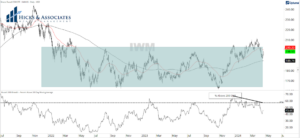The U.S. options industry is approaching a milestone. On April 26, the industry will celebrate its 50th anniversary.
During the past five decades, options have evolved from a curiosity—traded by a few pioneering souls with great math skills in the old smoking lounge at the Chicago Board of Trade—into one of the world’s most important markets. At last count, 16 U.S. options exchanges belonged to the Options Clearing Corp., which issues and settles all options contracts.
The growth in trading volume has been astounding. In 2000, it was remarkable if a million contracts traded on a given day. Now, 45 million contracts a day often trade, and it is treated as a natural occurrence.
Still, the activity is often misunderstood. A lot of the trading volume growth reflects institutional investors using options to reshape portfolio risk and returns.
Unfortunately, the options industry has helped advance the perception that puts and calls are suitable only for aggressive speculation by introducing more options that expire in extremely short times. The short-term options-trading mania generates profits for exchanges and trading firms, but at the cost of fostering misperceptions.
The investment industry—financial advisors, institutional consultants, family offices, and pensions—is struggling to understand how best to use options. A solution may soon emerge. Cboe Global Markets (ticker: CBOE), which launched the first U.S. options exchange in 1973, is planning 50th anniversary galas in major cities. The gatherings could spark the next generation of growth. The timing is opportune.
Demographic trends, coupled with a growing need for income to fund underfunded retirements, are a major issue in the U.S. and many other countries.
People are living longer than expected. They risk running out of money. They might get lucky and capture another multidecade bull market—or not.
The need to augment traditional portfolio allocations of stocks and bonds creates an opportunity for the options industry to demonstrate the value of simple, conservative strategies like selling call options on blue-chip stocks, also called the covered-call strategy. It entails selling a call on a stock you own with a strike price about 10% higher than the associated stock price.
This allows investors to receive a payment that often compares favorably with common stock dividends, making this an ideal strategy for income-hungry retirees.
The amount of money that could be generated with the covered-call strategy might even satisfy the annual required minimum distributions that retirees take each year. The strategy should be able to increase stock returns by 2% to 4%. Other than limiting your gains if the stock rises above the strike price, the risks are minimal.
But this simple idea requires thought and action on matters many people prefer to avoid or outsource. And the active management of passive investments runs counter to how the investment industry wants people to manage their affairs.
Here’s a prediction in the form of a challenge for the industry: Major exchanges have evolved into large public companies focused on increasing trading volumes to satiate institutional investors’ demand for ever better short-term financial results. They need to embrace something larger than their immediate financial self-interest.
Statesmanlike leadership and intense competition made the industry successful, and they could contribute to an even more prosperous next 50 years if investors, big and small, begin to understand that conservative options strategies can do a lot to enhance investor portfolios.
—
Originally Posted February 16, 2023 – How Options Trading Could Help Solve the Retirement Crisis
Updated February 17, 2023 / Original February 16, 2023
Steven M. Sears is the president and chief operating officer of Options Solutions, a specialized asset-management firm. Neither he nor the firm has a position in the options or underlying securities mentioned in this column.
Disclosure: Interactive Brokers
Information posted on IBKR Campus that is provided by third-parties does NOT constitute a recommendation that you should contract for the services of that third party. Third-party participants who contribute to IBKR Campus are independent of Interactive Brokers and Interactive Brokers does not make any representations or warranties concerning the services offered, their past or future performance, or the accuracy of the information provided by the third party. Past performance is no guarantee of future results.
This material is from Barron's and is being posted with its permission. The views expressed in this material are solely those of the author and/or Barron's and Interactive Brokers is not endorsing or recommending any investment or trading discussed in the material. This material is not and should not be construed as an offer to buy or sell any security. It should not be construed as research or investment advice or a recommendation to buy, sell or hold any security or commodity. This material does not and is not intended to take into account the particular financial conditions, investment objectives or requirements of individual customers. Before acting on this material, you should consider whether it is suitable for your particular circumstances and, as necessary, seek professional advice.
Disclosure: Options Trading
Options involve risk and are not suitable for all investors. Multiple leg strategies, including spreads, will incur multiple commission charges. For more information read the "Characteristics and Risks of Standardized Options" also known as the options disclosure document (ODD) or visit ibkr.com/occ












![[Gamma] Scalping Please [Gamma] Scalping Please](https://ibkrcampus.com/wp-content/smush-webp/2024/04/tir-featured-8-700x394.jpg.webp)
![[Gamma] Scalping Please [Gamma] Scalping Please](https://ibkrcampus.com/wp-content/uploads/2024/04/tir-featured-8-700x394.jpg)













